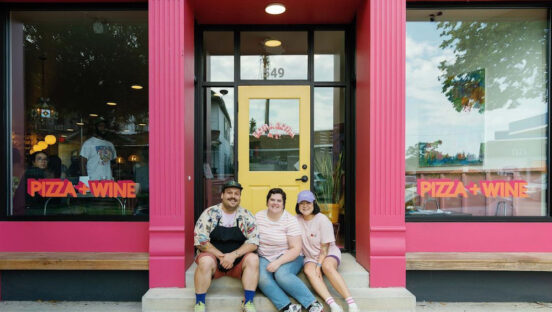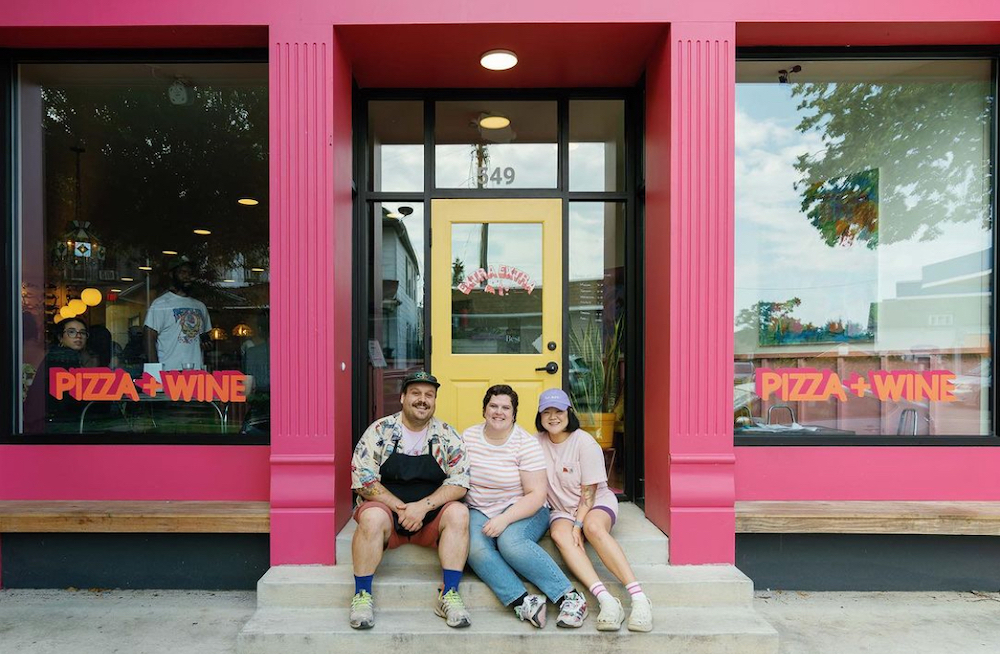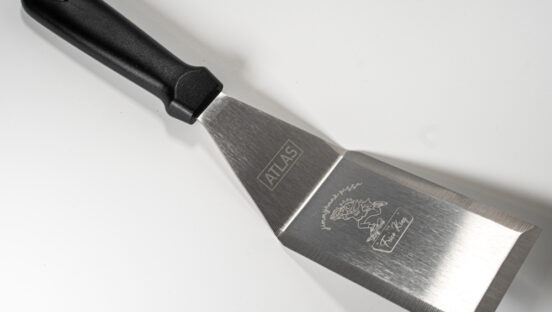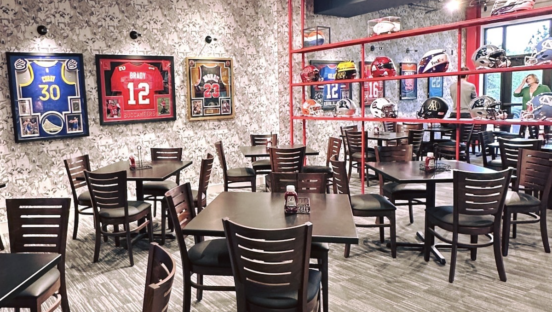As seasoned restaurant workers, Bridget Murphy and Joey Pucciarelli, a married couple, and their friend Soon Ho Sim, know how it feels to go home at the end of the night feeling ripped off—so much hard work and, all too often, so little pay to show for it, especially in tips.
Now, as the co-founders of Extra Extra Pizza in Buffalo, they’ve created more equitable jobs for everyone involved at their restaurant, thanks to a co-op business model that puts employees on track to become worker-owners in less than two years.
Extra Extra Pizza opened in 2022, offering New York-style pies and natural wines in an inclusive atmosphere (even the seating is designed for various body types) where both guests and employees come first. It’s a tricky balancing act for restaurant operators, one that many don’t even bother to try. To figure it out, Murphy, a sommelier, Pucciarelli, a veteran pizza maker, and Sim, a social media strategist, underwent an intensive 11-week course through Cooperation Buffalo, which supports the start-up of new worker cooperatives and helps convert existing businesses to worker ownership.
There’s no tipping at Extra Extra Pizza, and every employee, whether front- or back-of-house, gets paid the same living wage. Workers can earn a path to ownership in 18 months, and everyone is cross-trained on every station in the restaurant. Once vested, worker-owners have decision-making power and get a share of the restaurant’s profits based on hours worked.
But making a big, fat profit isn’t foremost on the worker-owners’ minds. In this Q&A with PMQ, Murphy explained the goals for Extra Extra Pizza and how going tipless and paying the same living wage to all makes for happier team members, who, in turn, make their guests happier.
PMQ: Can you explain what’s meant by a “co-op” in terms of Extra Extra Pizza ownership?
Bridget Murphy: So we are incorporated as a worker-owned cooperative business. There are many different ways in which a co-op can function, but, at its core, it means that anyone who works for the business has an opportunity to become an owner and that business decisions are made democratically. We currently have three founding worker-owners and will add our fourth in late March! We do take it a step further and have full financial transparency within the company. All workers have access to our full books, and everyone who works for us—owners and workers—are paid the same hourly wage. Because of this pay structure, we are fully tipless too!
PMQ: How did Extra Extra Pizza get started? And what were your goals for it, aside from, obviously, making a living in pizza? Can you talk specifically about your goals for creating a more equitable workplace?
Murphy: Myself and my husband were looking to open our own spot for about seven years, and we were starting to get serious in 2019 and 2020. When the pandemic hit in March 2020 and we all were suddenly unemployed and saw how much our friends who had businesses were struggling, we realized restaurants needed a much bigger safety net—and different margins—than was the industry standard. At this point, we started looking at cooperative structures and brought our friend, Soon Ho Sim, into the project and got to work! Buildout happened during COVID, which was slow, so we finally flung our doors open in August of 2022.
Our goal behind Extra Extra was to create a work environment that we could retire working at. So many people see restaurant work as a stop-gap between careers, and we wanted to make food and beverage our career! Every facet of the business is working towards that goal, from how we structure staffing, wages, benefits, our size, everything!
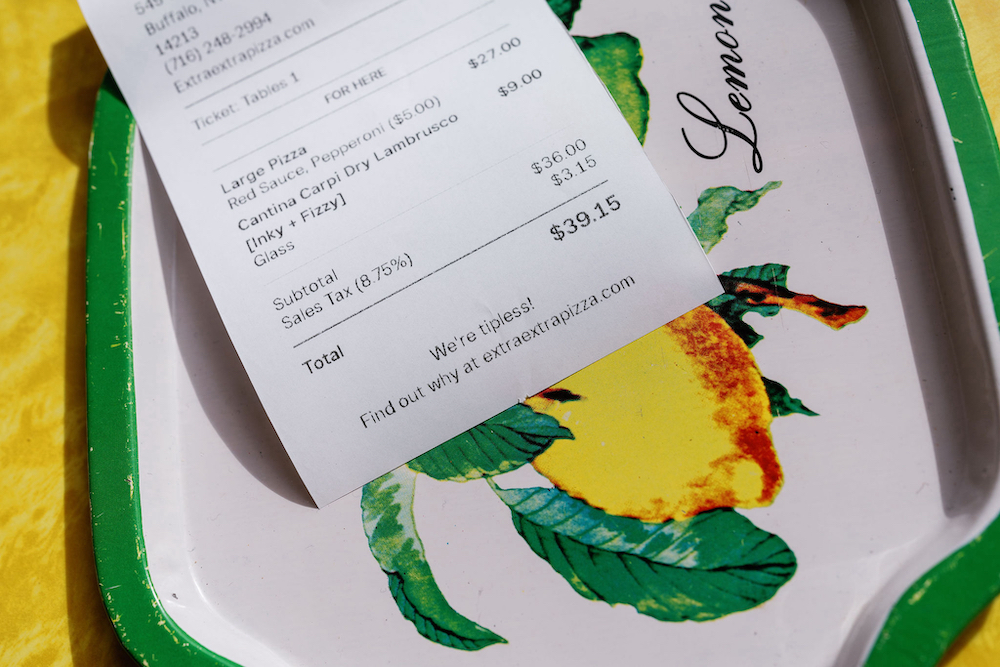
PMQ: How have you priced your menu so that you can pay employees fairly and still maintain a solid profit margin?
Murphy: When we were doing market research, we looked at prices at all different pizzerias in Buffalo, but we also looked at prices for a “meal” in our area. Our shop is located in the 5 Points neighborhood on Buffalo’s west side—we live here too. It’s an area that has recently seen a lot of development and gentrification. It was really important for us that our space be accessible for people living in the neighborhood who are already dealing with higher housing costs, less parking, and other things that development/gentrification can bring.
For this reason, a large cheese and pepperoni pizza has a bit of a lower profit margin, because we wanted to keep it under $30 forever—think of Arizona Iced Teas! Conversely, some of our “premium” items are priced a bit higher to make up for that difference.
As a general rule, because we’re tipless, instead of adding a 20% service charge onto the end of the bill, we (roughly) add that onto the menu price. We then look at the cost as a team and decide if it seems fair, too high or too low, and adjust from there. I think, with pizzerias especially, there’s such a varied cost of ingredients and toppings, so it’s hard to do a strict percentage-based pricing structure.
Another way we’ve been able to add value to our items is by making everything in house. Our vinaigrette is homemade, all veggies come whole and are broken down and cooked or pickled in-house, and the sausage and meatballs are homemade. This again lowers our food cost, and while it does increase labor cost, it still ends up being more affordable than buying prepped ingredients, and it tastes way better! And there’s less waste. But this only works if you’re tiny—we have less than 30 seats in house—and your staff has some culinary background.
Lastly, we’re still able to maintain a profit margin because all “owners” work as employees on the floor and are paid for that work. We recognize there are so many tasks—and risks—that owners take on, but we share in that workload and burden, so the profits don’t need to pay for a full owner’s salary if that makes sense?
PMQ: Yep, it does. So how do your customers feel about your no-tipping rule and how it affects your menu pricing?
Murphy: I think we fill a niche market because we worked really hard to make the dining room a nice place to be in! And we worked hard to have a nice drink menu, without being “fancy.” So while some of our prices are higher than a standard pizzeria, we still are more affordable than a typical restaurant in Buffalo. I also find that the tipless concept really resonates with people, and they’re happy to pay a little “extra” to know that workers are being compensated.
Something we consistently get on our Google reviews is how “friendly” and “helpful” the workers all are. I’ve worked in a lot of different restaurants, and I’ve never seen that before! I think that’s a direct correlation to our pay structure and how that’s changed the relationship between cooks and service staff and in worker-and-guest [relations]. We intended to level the playing field, and I think happy workers make happy guests!

